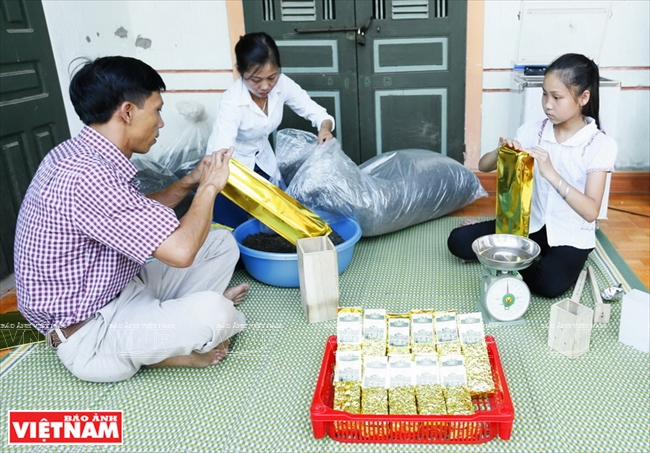From building models of producing and processing safe tea...
According to Hanoi’s Agricultural and Rural Development Department, in the last three years Hanoi’s agricultural sector has focused on establishing many models of cultivating and producing safe tea with VietGap standards. It has also zoned areas for growing tea, selected tea varieties of high yield and high quality, gradually replaced terraced-fields of old tea and applied science-technology and mechanisation to production.
Hoang Thi Hoa, Director of Hanoi Crop Development Centre, said that the centre successfully built farms of hundreds of hectares for growing safe tea in the communes of Ba Trai, Thuan My, Cam Linh, Yen Bai (Ba Vi), Hoa Thach (Quoc Oai) and Bac Son (Soc Son). It also chose some new varieties of tea, such as LDP1, LDP2, PH8, Kim Tuyen, Bat Tien, and Phuc Van Tien, which are suitable to the climate and soil of these areas, thereby developing strongly with large buds.

Farmers in the middle and mountainous areas in Hanoi use tea cutting machines
which help the tea plants avoid being bruised and quickly recover, increase productivity, quality
and reduce production expenditure, labour force and prices. Photo: Hoang Ha/VNP

Many new varieties of tea are suitable to the weather and soil of the middle and mountainous areas in Hanoi.
Photo: Hoang Ha/VNP |
To develop models of cultivating and producing tea with VietGap standards, the centre has organised 59 training courses for thousands of cadres and farmers, providing them with skills of management, tea cultivation, intensive farming and scientific and technological application to process and preserve the tea. Besides, the centre regularly held trips for delegations to popular tea growing areas in Vietnam, including Hoang Su Phi (Ha Giang), Dong Hy and Tan Cuong (Thai Nguyen) to exchange experiences in tea cultivation and learn how to use specialised tea cutting machines which help the tea plants avoid being bruised and quickly recover, increase productivity, quality and reduce production expenditure, labour force and prices.
...to a sustainable direction for poverty escape
At present, the total area for tea cultivation reaches over 3,000ha with a productivity of 7.54tons/ha and the output of fresh buds of 22,682tons. After implementing the model of intensive farming with VietGap standards, each hectare of tea brings about 1,730kg of dried tea buds/year which is sold for 200 thousand dong/kg. After reducing all expenses, farmers earn a profit of 200 million dong/ha, much higher than the traditional model that brought about over 100 million dong/ha/year.
Seeing a potential profit brought about by the new model, farmers in midland and mountainous areas in Hanoi are eager for cultivating and producing safe tea with VietGap standards. Nguyen Thi Son, Chairwoman of the People’s Committee of Ba Trai Commune said that in the future Ba Trai will replace all low-yield tea plants with new varieties in 372ha and expand an additional area of 50ha, ensuring 100% of the commune’s tea growing areas to meet VietGap standards with scientific and technical application.

Nguyen Quy Quyet, a cadre of the Hanoi Crop Development Centre, instructs farmers on harvesting tea
in Hoa Thach Commune, Quoc Oai District (Hanoi). Photo: Hoang Ha/VNP

Producing safe tea in Ba Trai Commune, Ba Vi District, Hanoi. Photo: Hoang Ha/VNP

The family of Nguyen Van Hoang (checked blouse) is one of the exemplary families
in developing the trademark of Ba Trai green tea in Ba Trai Commune, Ba Vi District. Photo: Hoang Ha/VNP

Ba Trai green tea produced by Nguyen Van Hoang’s family in Ba Trai Commune, Ba Vi District, Hanoi.
Photo: Hoang Ha/VNP |
Based on the success of the project on safe tea production and intensive cultivation under VietGap standards, the authorities in Hanoi assigned the centre to map out a plan on developing tea with high-tech application in the 2016-2020 period, with a focus on four tea areas of Ba Vi, Soc Son, Chuong My and Quoc Oai with a total area of 1,000ha. Participating in the project, farmers will receive the city’s assistance for building roads, irrigation systems, environment treatment, 80% of prices of seedlings and expenditure for insect prevention. Furthermore, the centre will support the building of three experimental models and 9 replicas for showing tea production and processing with high tech application to encourage farmers and enterprises to participate in the project, opening up a sustainable direction of poverty escape for locals in midland and mountainous areas in Hanoi.